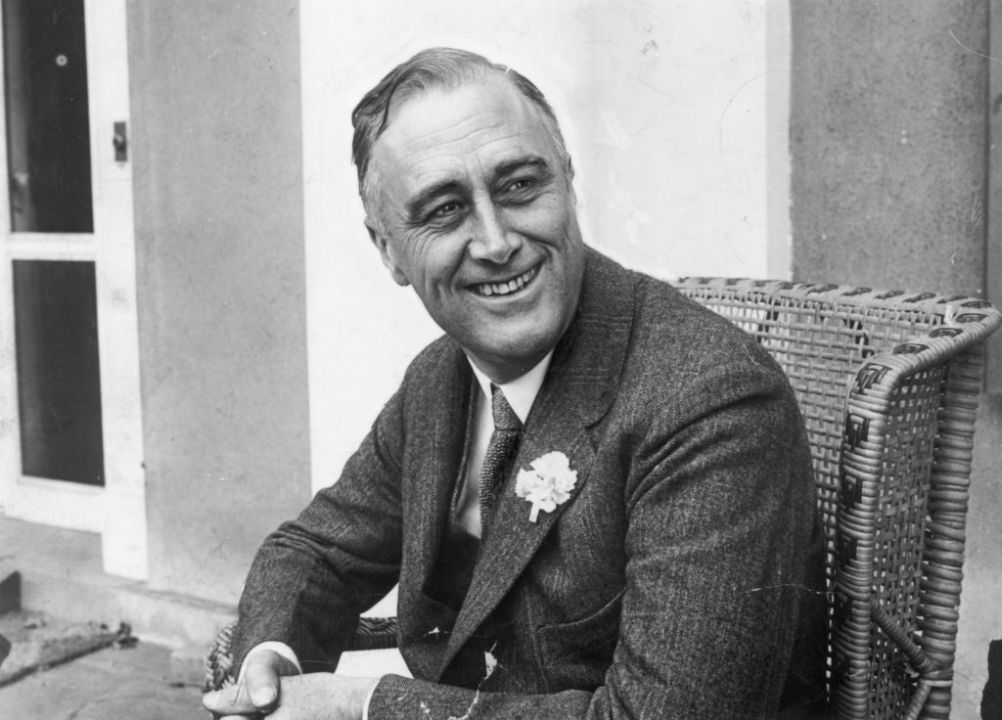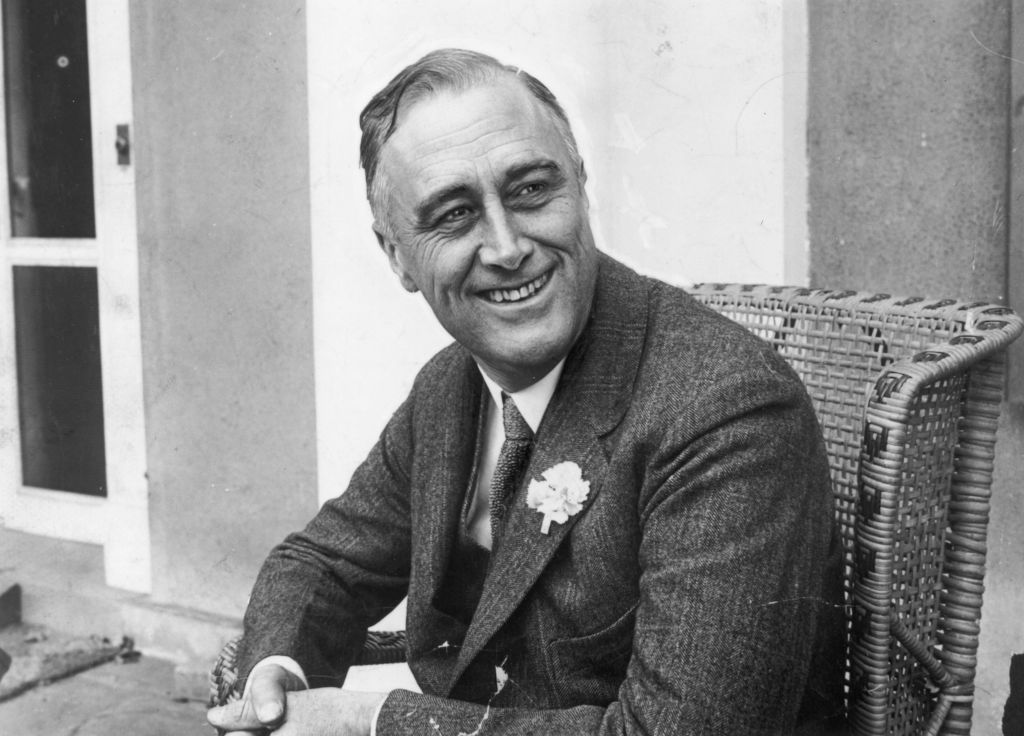Many of those around Franklin Roosevelt were puking their guts out – but he could not have been happier. It was July 1918 and Roosevelt was crossing the Atlantic on his way to Europe on an official trip as assistant secretary of the Navy. Apart from rather forlorn attempts to sleep while the USS Dyer bobbed up and down in the deep North Atlantic swell, Roosevelt revelled in everything he experienced. Roosevelt loved being at sea and he had chosen, deliberately, to travel in a destroyer, the small nimble vessels that did much of the fleet’s dirty work. The destroyer he was on was newly constructed and manned with a green crew – which quickly showed. As the Dyer rose and fell, changing course regularly to trick any German submarines that might be tracking it, many in the crew became green with sea-sickness. Roosevelt, who prided himself on being an excellent sailor with a cast-iron stomach, admitted that things got so bad that the vessel smelled not so much like a warship but ‘like a street in Haiti’.
Roosevelt was not just happy because he avoided seasickness when many of those around him did not. He was particularly delighted because he was off to see war first-hand. Only 36 years of age, vigorous and still with the use of both of his legs, Roosevelt cut a dashing and forceful figure. His visit to Europe in the summer of 1918 would be a formative experience in his strategic education, and help shape his grand strategic outlook for world war two.
The smells of the war on land – the strange combination of decaying bodies mixed with gunpowder and garbage – disgusted him
Even the trip across the Atlantic was an eye-opener. Roosevelt had always been a believer in the naval theories of Admiral Arthur Thayer Mahan, and believed that the control of goods and supplies across the seas, which he would have referred to as Communications, was the sine qua non of success in war. For much of the previous year, ever since the US had joined the war as a combatant in April 1917, Roosevelt had been obsessed with the German submarine threat to Allied trade. During the trip he was hoping to see a German submarine be found and depth-charged. In the end, not a single German submarine was spotted.
The reason, as Roosevelt understood, was that Allied war and merchant ship production had basically provided so much materiel by the summer of 1918 that the Germans had lost the sea war. Roosevelt was travelling in a convoy, much of it like the Dyer, composed of this new equipment, and he could see the industrial might of the UK and USA in full flight.
When he arrived in the UK he received his first experience of the diplomatic side of grand strategy. The British government even laid out the red carpet for him. Understanding that Roosevelt was far more than an average assistant secretary of Navy, probably because of his relation to Theodore Roosevelt, the most famous US politician of the time, the British enthusiastically embraced him. Roosevelt had long, private audiences with the prime minister, David Lloyd George, and the first lord of the Admiralty, Sir Eric Geddes. Both older men, who were vital to the running of the British war effort, complimented Roosevelt on his strategic understanding and listened intently to his ideas. Roosevelt was even given a private audience with King George V in Buckingham Palace. Though the meeting was only supposed to last 15 minutes, the two hit it off so well (they shared a mutual dislike of the Germans) that the audience lasted for 45 minutes – or so Roosevelt boasted.
Roosevelt liked everyone he met, with one notable exception: Winston Churchill. The two met at some event during the visit, and Churchill made a terrible impression on Roosevelt, so much so that many years later Roosevelt, when president, described Churchill as a ‘stinker’ when talking with his ambassador to the UK Joseph Kennedy. Churchill claimed not to remember their encounter – which might have been the problem. Churchill might not have understood the importance of the ambitious young American, and paid him no attention. It was a sign that their relationship was never as close as many people assume.
One thing the British also did was indulge Roosevelt in his one of his most illustrative war fighting plans. Roosevelt wanted to permanently disable the German submarine threat by fighting Germany on an unprecedented industrial level. His plan was to lay a deep, wide mine barrier which would stretch from the British coast to the Norwegian coast – fully closing off access out of the North Sea for the German fleet. The British had previously considered such a massive effort as too wasteful for the gains it might accrue, but with Roosevelt hectoring them, they gave way. As long as the US paid (which Roosevelt made sure they did), Roosevelt could have his North Sea mine barrage.
Roosevelt set about putting it into place with extraordinary energy. For the rest of the visit, he would visit or check up regularly on the growth of his strategic baby, following its progression with a fierce protectiveness. Its importance is not always understood as the barrage was not complete before the war ended only a few months later, so some have dismissed it as a white elephant. However for Roosevelt it was the way that industrial democracies needed to fight. It was a plan based on using technology and industrial might to control communications – while at the same time not risking high casualties. If the barrage did not achieve what he wanted in world war one, its existence in different forms would typify how he would fight world war two.
Of course Roosevelt did not spend all his time in the UK during the visit. After a while, he crossed the Channel into France, where he came face to face with a large land war for the first and only time in his life. First Roosevelt stopped in Paris, where he had a wonderful interview with the French premier Georges Clemenceau. He was captivated by the elderly and sprightly Frenchmen, who told him a striking story of the discovery of a French and German soldier, locked together in a blasted trench, killed in the act as they were both trying to bite the other to death.
It was a fitting introduction to what Roosevelt would see for himself. From Paris he travelled to the western front, to see US troops in action and learn what he could about the land war. He was instantly repelled. The smells of the war on land – the strange combination of decaying bodies mixed with gunpowder and garbage – disgusted him and he could not understand how army officers were able to tolerate it so easily. He was also given a VIP tour of the famous battlefield at Verdun. Still an active theatre of war, Roosevelt was escorted, under the constant threat of German fire, into the famous Fort Douaumont – which had changed hands between German and French forces during the height of the battle. He ended up spending the night at another French fort, and found the whole experience oppressive. Being forced to sleep in such close quarters with so many others – smelling their body odour and rebreathing their air – made him ill.
From this visit onwards Roosevelt would be repulsed by the war on land, and engaged with it as little as possible. He was a man of the sea, and later the air. One final thing he did was visit military airfields in northern France, where aircraft were used to attack German lines and in return were attacked by German aircraft. This was to Roosevelt a crucial new technology that needed to be integrated into his strategic calculation.
Of course Roosevelt could not stay in Europe forever. On 11 September he embarked to sail back to America – educated about war in a totally different way. Even the trip back would make an indelible impression on him. He almost immediately came down with the Spanish flu while onboard, and when he arrived back in America was so weak that he had to be brought off the boat on a stretcher, and could not work again for a month. Crucially, he was too weak to unpack his own belongings, and that was left to his long-suffering wife Eleanor. It was while she was sorting through his luggage that Eleanor discovered that their happy home life was a lie. She came across love letters between Franklin and Eleanor’s trusted correspondence secretary, Lucy Mercer. It was a stunning betrayal, and while Franklin and Eleanor would remain married, their relationship would never be the same. They would from that moment on become a professional couple more than a personal one – only periodically sleeping in the same house, and hardly ever in the same bed.
The Roosevelt that returned to the United States from Europe was very close to being the great strategist who would dominate the US war effort from 1941 until his death in April 1945. He was confirmed in his idea that the US should always prioritise the building of machines over the wasteful use of manpower. He wanted the US to gain sea and air dominance first and foremost, and limit the land warfare, which he found repellent, to only necessary theatres. He had learned diplomatic lessons on how to interact with British and European elites, and even started to gain the measure of Winston Churchill. A grand strategist was being born.
Phillips O’Brien’s new book, The Strategists, is released on 15 August.








Comments